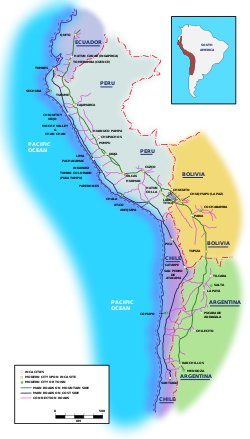This article needs additional citations for verification. (October 2022) |
| Part of a series on |
| Human history |
|---|
| ↑ Prehistory (Stone Age) (Pleistocene epoch) |
| ↓ Future |
| History of Peru |
|---|
 |
|
|

The Andean civilizations were South American complex societies of many indigenous people.[1] They stretched down the spine of the Andes for 4,000 km (2,500 miles) from southern Colombia, to Ecuador and Peru, including the deserts of coastal Peru, to north Chile and northwest Argentina. Archaeologists believe that Andean civilizations first developed on the narrow coastal plain of the Pacific Ocean. The Caral or Norte Chico civilization of coastal Peru is the oldest known civilization in the Americas, dating back to 3500 BCE.[2] Andean civilizations are one of at least five civilizations in the world deemed by scholars to be "pristine." The concept of a "pristine" civilization refers to a civilization that has developed independently of external influences and is not a derivative of other civilizations.[3]
Despite the severe environmental challenges of high mountains and hyper-arid desert, the Andean civilizations domesticated a wide variety of crops, some of which, such as potatoes, peppers, peanuts, manioc, chocolate, and coca, became of worldwide importance. The Andean civilizations were noteworthy for monumental architecture, an extensive road system, textile weaving, and many unique characteristics of the societies they created.[4]
Less than a century prior to the arrival of the Spanish conquerors, the Incas, from their homeland centered on the city of Cusco, united most Andean cultures into one single empire that encompassed nearly all of what is usually called Andean civilization. The Timoto Cuica of Venezuela remained outside the Inca orbit. The Inca Empire was a patchwork of languages, cultures and peoples. Spanish rule ended or transformed many elements of the Andean civilizations, notably influencing religion and architecture.
- ^ "Pre-Columbian civilizations - Andean, Inca, Moche | Britannica". www.britannica.com. Retrieved 2023-07-31.
- ^ Shady Solis, Ruth; Jonathan Haas; Winifred Creamer (27 April 2001). "Dating Caral, a Preceramic Site in the Supe Valley on the Central Coast of Peru". Science. 292 (5517): 723–726. Bibcode:2001Sci...292..723S. doi:10.1126/science.1059519. PMID 11326098. S2CID 10172918.
- ^ Upton, Gary and von Hagen, Adriana (2015), Encyclopedia of the Incas, New York: Rowman & Littlefield, p. 2. Some scholars cite 6 or 7 pristine civilizations. ISBN 0804715165.
- ^ "Pre-Columbian civilizations - Andean, Inca, Moche | Britannica". www.britannica.com. 2024-09-08. Retrieved 2024-10-18.